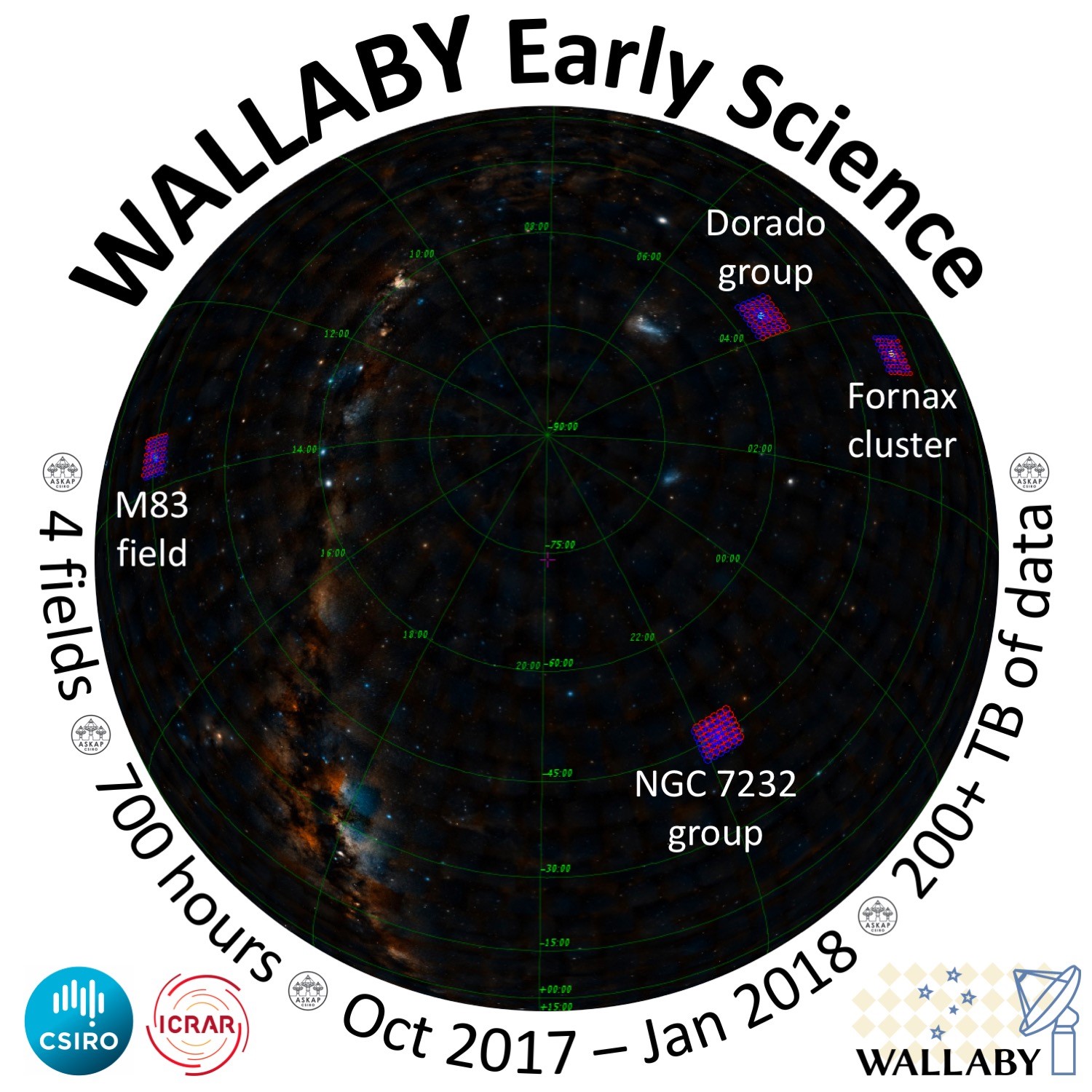WALLABY Survey Science Team - ASKAP commissioning odyssey
The past 17 months of working with ASKAP has been quite the journey! Starting with a simple email on the night of 11 August 2016. It was from Robin Wark, one of the technical operators of ASKAP, stating that the ASKAP Design Enhancement (ADE) array was ready for testing and that the NGC 7232 group, a nearby system of neighbouring gas-rich galaxies, would be a good pilot field. I was thrilled and quickly replied to verify the observing details that had been submitted a few weeks prior on behalf of WALLABY, the Wide-field ASKAP L-Band Legacy All-sky Blind survey (Principal Investigators: Baerbel Koribalski & Lister Staveley-Smith).
Two hours later Aidan Hotan, ASKAP Project Scientist, focused 12 ASKAP antennas, all newly-equipped with MkII phased array feeds (PAFs), on the radio emission from a group of galaxies located about 20 Mpc (70 million light years) away. That night the ingest buffers were hovering at 50% full, there were periodic patches of bad performance and a power supply tripped for one of the antennas but eventually ASKAP completed a 12-hr observation run with 36 beams and a modest 48 MHz of bandwidth (with 18.5 kHz channel resolution).
Commissioning observations, led by the ASKAP Commissioning and Early Science (ACES) team, continued for the next few weeks and usable science data was trickling in. The ASKAP spectral line data processing working group was ramping up its effort and helping to identify issues with both the array and ASKAPsoft - the in-house developed data processing tool. Scientists, engineers and software designers worked together to solve problems and each iteration was a step towards ASKAP becoming more stable.
On 7 October 2016, ASKAP-12 officially started its Early Science program with further observations on the NGC 7232 group. Radio emission data, that would inundate any personal computer with its sheer volume, started to pour in. Using the Pawsey Supercomputing system, astronomers diligently continued their efforts to process and image the data with various ‘old tricks’ as well as new tools that were made available through ASKAPsoft. Things were going well and by Christmas holidays, ASKAP-12 was able to observe 24-hrs a day with minimal human intervention.
However, as the expansion of the array (in both the number of antennas and overall capability) continued in January 2017, something went astray. With several additional inputs, the spread of data arrival times across the correlator (the part of ASKAP that combines the signals from individual antennas to make the antennas function as one telescope) started to cause alignment errors. Eventually the problem became so severe that observations were called to a halt. Intensive investigations by the engineering staff revealed a number of issues, deep within the ASKAP system, that needed to be fixed. Consequently, Early Science operations paused for half a year – a lengthy break, but part of the risk associated with early access to such an advanced telescope.
In late August 2017, ASKAP was back online and once again ready to correlate radio signals! The Early Science program resumed and several Survey Science Teams were conducting observations. We now have 16 antennas (which halves the required time on source when compared to ASKAP-12) working together to each receive data from 36 beams over 240 MHz of instantaneous bandwidth. Sitting at my desk on a sunny afternoon in January 2018, I used the ASKAP Observation Management Portal to watch the final telescope scans of the Dorado group – another nearby system of galaxies – which signified the completion of WALLABY Early Science observations.
Overall, WALLABY has collected just over 700 hrs of commissioning and Early Science observations on four different science fields: the NGC 7232 and Dorado groups, Fornax cluster, and field around the M83 spiral galaxy.

The 220 TB of raw data will produce high resolution neutral hydrogen image cubes with full WALLABY sensitivity (i.e. have an RMS noise of 1.6 mJy/beam per 4 km/s channel) of the four fields. These cubes will provide detailed maps of the hydrogen gas content of the nearby systems and enable the discovery of new galaxies.
The next step for us will be verifying the ASKAP data products and analysing them for scientific purposes. The next step for ASKAP will be incorporating all 36 PAFs (the last one was installed on 17 November 2017) and other newly implemented features to transform itself into a high-speed, high resolution survey instrument that will truly help us discover and understand the Universe.
Page written by Karen Lee-Waddell. Page maintained by Annabelle Young. Last updated 31-Jan-2018
